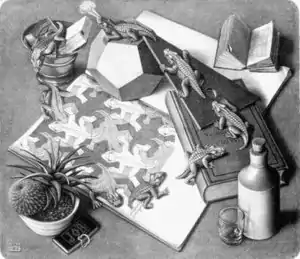Reptiles (M. C. Escher)
Reptiles is a lithograph print by the Dutch artist M. C. Escher first printed in March 1943.[1] It touches on the theme found in much of his work of mathematics in art.
| Reptiles | |
|---|---|
 | |
| Artist | M. C Escher |
| Year | 1943 |
| Type | lithograph |
| Dimensions | 33.4 cm × 38.5 cm (13.1 in × 15.2 in) |
Work
Reptiles depicts a desk upon which is a 2D drawing of a tessellated pattern of reptiles and hexagons, Escher's 1939 Regular Division of the Plane.[2][3][1] The reptiles at one edge of the drawing emerge into three dimensional reality, come to life and appear to crawl over a series of symbolic objects (a book on nature, a geometer's triangle, a three dimensional dodecahedron, a pewter bowl containing a box of matches and a box of cigarettes) to eventually re-enter the drawing at its opposite edge. Other objects on the desk are a potted cactus and yucca, a ceramic flask with a cork stopper next to a small glass of liquid, a book of JOB cigarette rolling papers, and an open handwritten note book of many pages. Although only the size of small lizards, the reptiles have protruding crocodile-like fangs, and the one atop the dodecahedron has a dragon-like puff of smoke billowing from its nostrils.
Like many of Escher's works, the meaning of the imagery is enigmatic. There are, however, a number of scholarly interpretations of the work. One is that the lizard represents man, emerging from pure concept in two dimensions, becoming a three dimensional being, groping through life acquiring knowledge and wisdom, arriving at deep understanding of science and sacred geometric principals and the alchemical/spiritual nature of reality and existence, and finally descending to reunion with the realm of pure concept. In this theory the objects around the edge of the drawing are signals of the stages of emergence (cactus, biological life), the beginning of the fire-quest for knowledge (rolling papers), contemplation and distillation (a jug and partially consumed glass of spirits), deep study, understanding and wisdom (the open well-used notebook), and re-integration (matches and cigarettes symbolizing controlled/civilized fire that nonetheless consumes and returns the physical to the abstract).
Once a woman telephoned Escher and told him that she thought the image was a "striking illustration of reincarnation".[1]
The critic Steven Poole commented that one of Escher's "enduring fascinations" was "the contrast between the two-dimensional flatness of a sheet of paper and the illusion of three-dimensional volume that can be created with certain marks" when space and flatness exist side-by-side and are "each born from and returning to the other, the black magic of the artistic illusion made creepily manifest."[4]
In popular culture
A colorized version of the lithograph was used by the rock band Mott the Hoople as the sleeve artwork for its eponymous first album, released in 1969.[5]
References
- "Reptiles in Wartime". Escher in het Paleis. 3 March 2018.
- Locher 1971, pp. 8, 15, 18; cf. also 78, 83, 85, 89.
- Locher 2006, p. 74.
- Poole, Steven (20 June 2015). "The impossible world of MC Escher". The Guardian. Retrieved 2 November 2015.
- Coulthart, John (2013-02-07). "MC Escher album covers". Archived from the original on 17 February 2013. Retrieved 2 November 2015.
Sources
- Locher, J. L. (1971). The World of M. C. Escher. Abrams. ISBN 978-0-451-79961-6.
- Locher, J. L. (2006). The Magic of M. C. Escher. Thames and Hudson. ISBN 978-0500512890.
External links
- Decoration with Escher Lizard by William Chow.
.jpg.webp)